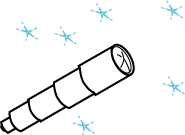creation: 09/06/99; modified 05/07/03, 08/09/17

Instructions: This is an ungraded fill-in-the-blank exercise. Each question consists of a statement with one or two words left out. A button represents the missing word(s). For each question, think of the word or phrase that should fill each blank, then click on the buttons to see if you are correct. No grade is calculated for this exercise.
When an instance variable and a parameter use the same identifier, you specify the instance variable of the object by saying "this.identifier" as in the above.
You don't have to use "this" in the method because it is clear that the identifiers
refer to the instance variables.
The magnification() method can not even see the parameters of the constructor.
You could also just use the second command.
The javac compiler will then do the first
automatically.
End of the Exercise. If you want to do it again, click on "Refresh" in your browser window.